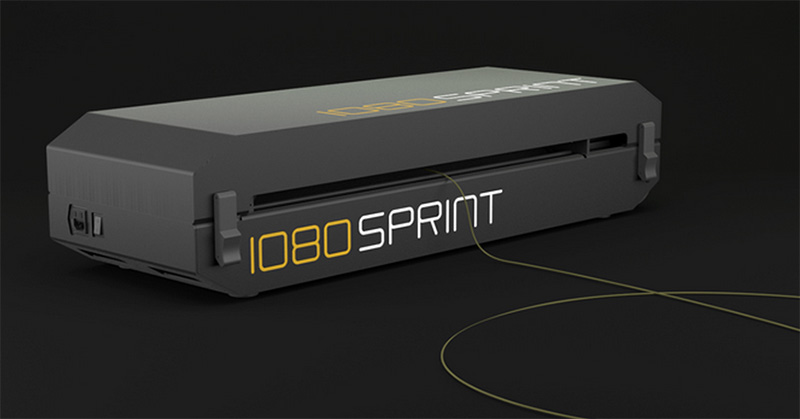
By Carl Valle
Every year the NFL Combine tests power and speed but rarely do the athletes get tested again. The reason is twofold: the athletes only need to prove themselves once, and many coaches are afraid to test and train speed because of the possibility of injuries to hamstrings and other muscle groups. Everyone is fearful of losing their job, and that is understandable.
But by not taking the risk, this hyper-conservative approach often backfires. Athletes usually lose speed by not training it, and injuries that result from not preparing for speed show up during games. The most precious gift in sport is speed, but it’s also a responsibility coaches are afraid to be involved with.
This article shows how to test safely and train speed while screening for injury. This solution is not a magic bullet, but the ability to train speed, test it, and screen for injuries—all at the same time—is a game changer.
Risk Factors with Sprinting in Team Sport Settings
An infographic on sprinting as one of the most important modalities to improving speed from Yann Le Meur is all over the internet. But while everyone is re-tweeting and sharing socially, the next week hardly resembles a speed training session on the field. While weight and jump training both help, sprinting is the number one standard for getting faster. With everyone falling prey to being conservative and using secondary modes of improving speed or, at least, preserving it, coaches who take reasonable risks are gaining the edge over their competition.
Three primary factors create the risk of pulling muscles:
- Effort – Athletes who run submaximal speed will likely not pull, but they will also likely fail to stimulate the body to either maintain speed or get better.
- Distance – Athletes who do super-short sprints usually don’t get enough velocity to prepare for games that may have longer possible bursts or higher outputs from arousal.
- Mechanics – Running mechanics are hard to change when athletes become elite because very little time is available to teach train and teach.
So what can coaches do besides the holding pattern of injury reduction exercises and hoping the practices do enough? Athletes fresh and fit from advanced monitoring are not immune to muscle pulls. With all the advancements in sport science and sports medicine, where are all the bulletproof teams and immortal athletes?
The truth is no matter how much one is educated, the practical side of the culture and legal constraints of collective bargaining agreements make it hard to implement the science. I have found success testing speed for years and never once had an injury, but having the luxury of small groups all wanting to train and sprint is not the same as other environments. Last year I found a simple solution that coaches are starting to adopt. With new technology, we are going to see a big revolution in speed training.
The Honest Truth of Why Teams Don’t Sprint
I surveyed a group of professional strength coaches, and they came clean with the problem of speed training during the season. Here’s the summary of their thoughts:
When athletes come in after an offseason, they are dealing with an unknown situation as weeks and months of training offsite is sometimes a ticking time bomb. The unknown unknowns are a risk, and testing sprints is a mixed bag. Testing speed shows how well an athlete has prepared, but testing also comes with the risk of pulling. So many coaches resort to movement screens, activation techniques, and injury reduction exercises.
What usually happens is a coach reading about speed but sitting on the sidelines and not training, and the next year the process repeats itself the next year. I have been conservative with new athletes and waiting for a few weeks before sprinting. But with short pre-season periods, sprint training and testing are rarely done.
Even if the coach is a risk taker and brashly wants to train and test speed, the athletes are often unwilling. They may see speed training as an unnecessary risk. Since they have a job after getting tested at combines, they feel they served their time. Speed training requires everything to be nearly perfect: The athlete must be ready to sprint and have proper mechanics, the coach must have a plan to load speed properly, and the training program must have the right tools to measure speed. All these factors may be viewed as the stars aligning or the speed gods blessing the coach, not something realistic.
Why Miminum Resistance Sprinting is Pure Gold
I have written about the value of warming up smarter to reduce injuries and a hamstring article to reduce their occurrence. Still, these are parts of a sprinting program, not replacements. Eventually, one must take the leap of faith and run fast. So what is the practical way of sprinting with less risk besides the workarounds above?
The answer for reducing risk in speed development is simple: Add a therapeutic load and sprint with light resistance in training.
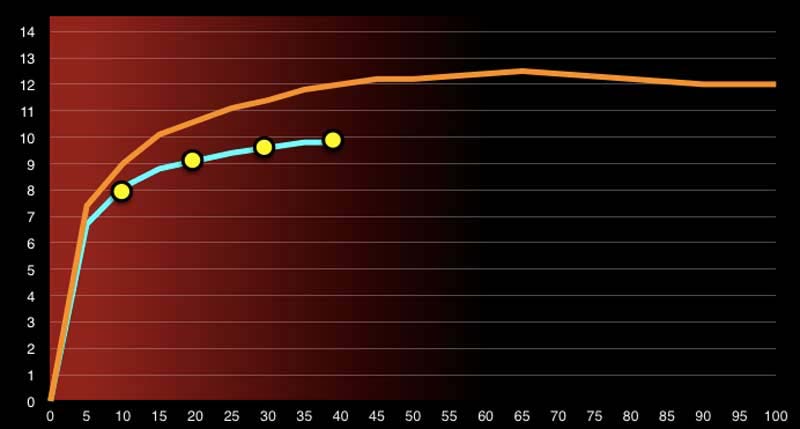
Figure 1: This curve shows one athlete’s acceleration pattern with load. Each athlete has a unique profile of overcoming inertia and changing velocity with resisted sprints.
Adding light resistance solves the problem of the risk of sprinting by addressing the three factors that coaches are afraid of or don’t have the option of removing. Light resistance does the following three things specifically tp reduce risk:
- Slows down the motion slightly, just enough to rehearse fast sprinting.
- Forces pushing mechanics that are more efficient and safer to the athlete. No overstriding that sometimes recruits the hamstrings too early and awkwardly.
- Encourages athletes to go hard instead of holding back from instant feedback.
I’ve seen several coaches use this method and finally get results. Injury rates decreased during the season and athletes stayed sharper even during the later phase of the year near playoff time. Athletes were more eager to sprint as they got benchmarked or tested for the first time in years. Everything worked perfectly by adding resistance instead of eliminating speed.
The Science (Evidence) of Minimum Resistance Sprinting
Sled pushing, sled marching, sled dragging, and similar exercises have some relative value in preparing athletes. My issue is that when preparing athletes, lighter is better. Nearly every study focuses on comparing sled training only, not entire programs. I have read dozens of studies, and I see the same thing. A researcher seeks to isolate the differences between sled loads compared to body weight. This is not the ideal way to train in the real world. I understand the need to isolate variables, but it’s better to do that in a holistic program. My article reviewing Boo Schexnayder’s speed workshop emphasizes the importance of harmonizing work. Sprinting at high velocities is essential nowadays.
This website has several articles on sled sprinting creating a case for loading based on velocity. I am not the only one advocating for the need to look at body speed more than body weight percentage.
Using the old concept of body weight percentage for sled loads is throwing darts in the dark. Share on X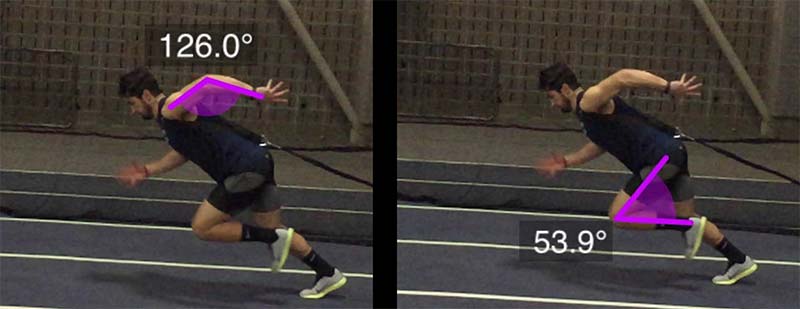
Figure 2: As the load increases, studies indicate specific kinematic and kinetic changes that are sometimes favorable and sometimes problematic, based on each athlete. Here the Dartfish app shows limb kinematics changing based on loading protocols. Overstriders need to cut overextension and flexion, and short striders need more RFD.
Everyone has their personal philosophy and many roads lead to Rome, but the analogy becomes reality when one has to get to Italy’s capital faster and more consistently. The best path is repeatable, clear, and safe. The following factors lead to successful speed development.
- Sprinting is a primary way of improving speed and is often overlooked because people overthink. Do the sprinting and things will fall into place.
- Strength and power are a neurological change, not an attempt to recreate visually sprinting motions with low intensity. Based on current research, the compromise of using low specificity movements and low loading in training yields very little.
- Heavy sled work has value, but usually, those athletes respond to a combination of fast sprinting and a conventional strength and conditioning program. Read the research to see what athletes are doing overall, not just in isolation.
- Small changes in contact time and kinematic motion occur at different loads. They can present an opportunity to change timing and technique over time as well as a potential problem in different parts of the acceleration for some.
- Overcoming inertia requires old school maximal strength or high volumes of sprinting. The fastest 10m ever recorded was accomplished without heavy squatting or even very much lifting, but long training calendars of sprinters are not models for most team sports.
- Sled work is usually a static load during short accelerations of less than 50m. Most coaches are trying work early departure, so they compromise the velocity at later parts of the sprint.
- Athletes produce resultant forces (lateral, vertical, horizontal) that change during the sled sprints because of posture and loading with some equipment. Coaches must be aware of this if they see dead spots with specific force profiles.
Most of these points support the use of a classic program that nearly all major sprint and strength coaches have implemented over the last 100 years. No need to reinvent the wheel unless an opportunity exists for something significantly better.
Coaching Minimum Resistance Sprinting
Everyday training of sprints is about adjusting the workout daily and planning seasonal speed development with goals. The old paradigm or training dogma about using body weight percentage has several flaws:
- Two athletes of the same weight may have different speed abilities, so using an arbitrary approach is convenient but not tailored and personalized.
- Two athletes may have similar speeds and weights but different strength abilities, so they respond differently to resisted sprints.
- Athletes who don’t get exposed to high effort and high speeds of sprint training need access to immediate work, so light loads are smarter.
- Athletes are usually going to have fatigue and speed abilities that fluctuate during the year and during the session itself.
Currently very little—if any—research exists on the velocity approach. That’s the reason coaches exist, and the right instrumentation helps support the innovators. Since the 1980s, some good studies have noticed crude trends with body weight and velocity based on general and average observations. In 2016, we can do better. Since 2009, I have been putting more time into velocity approaches to sled work, and this practice accelerated when I used timing for feedback. The evolution is continuing with more powerful options.
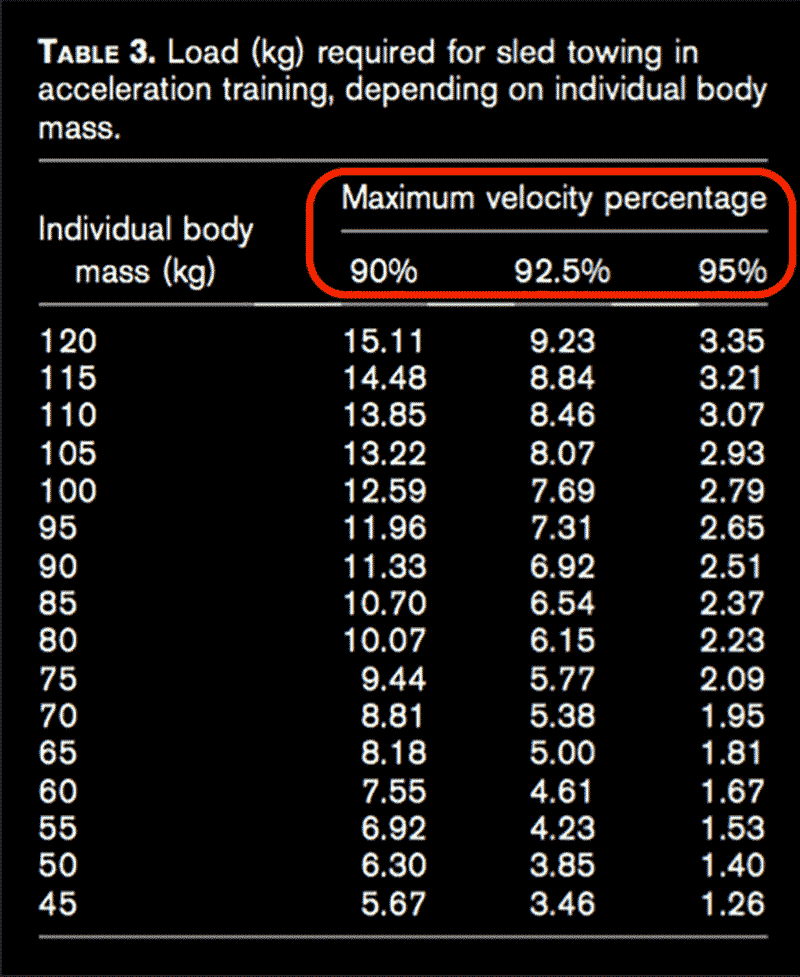
Figure 3: The above table was taken from Alcaraz and colleagues in 2009 and provides evidence to focus on the velocity changes of different phases of the sprints. Using more instant and higher resolution of splits (2-5 meter increments with 1 kilogram changes) is the future.
Nobody has a pure blueprint for success with body speed and acceleration curves, but many coaches are adopting the same approach to speed training with sleds as with barbell tracking and weight training. The 10% rule for speed is based on the entire run time, so coaches must decide where they want the speed to drop and by how much. The chart hints what the speed should be based on paper, but every day the coach has to see what the athlete is bringing to the table and adjust on the spot. The problem is that long accelerations will not address different sections of the acceleration so compromises are made. But using light resistance means the general training session will be successful.
The Results of Minimum Resistance Sprinting
I learned about athletes sprinting fresh at small doses from various coaches this past year. Light resistance sprinting in any form helps—meaning a good sled or slight incline is valuable—but one needs to get an accurate measurement of absolute speed to know what is trending up or down. After adding more super-light sleds as Todd Lane suggests, many coaches did speed work safely. It was a great start for everyone.
One issue still not addressed is the need to individualize not just the total resistance load, but the entire acceleration curve. Sled sprinting is one load that is rather static. Each athlete has small but noticeable areas that must be smoothed out. A coach usually has to limit the session to one area of development instead of improving the entire curve.
Enter the 1080 Sprint and Getting to the Next Level
Some coaches experimented with something more finite and advanced last year: using “robotic” resistance with speed training. While I was satisfied with timing sled sprints, like anyone in the sprint world I wanted more.
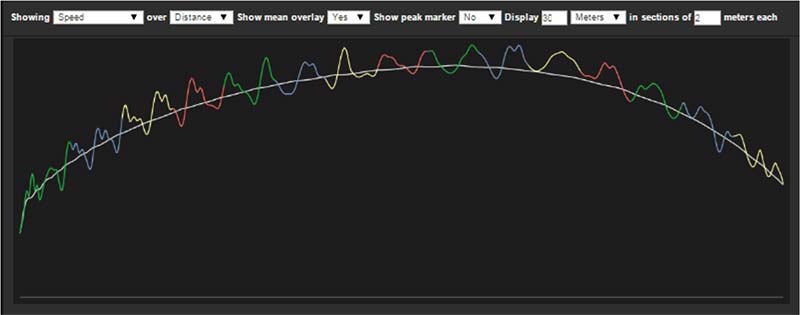
Screenshot 1: This is part of the acceleration curve showing every step. Note the mean (white line) and individual step count (colored line).
I found out about the 1080 Sprint from Randy Huntington last year as he suggested it as the marquee solution for coaches who are training speed. Randy shared the overspeed and sprint resistance device of the future, and Christopher Glaeser from SimpliFaster was determined to help provide it for performance coaches. I patiently gathered information on the 1080 Sprint and its potential.
The 1080 Sprint is the right tool for elite teams and facilities making their living from the evidence of their athletes getting faster. While I am a fan of quality sleds and have suggested timing using the Freelap Pro Coach, the 1080 is likely the best option because it does speed assessment and provides a spectrum of resistance at very precise increments. One obviously can get splits every 10m or so while adjusting the load with small plates, but this process loses several benefits. I have used the time and load for years and found ways to accomplish it by hand. But four features I found indispensable require the 1080 Sprint.
- Stride asymmetry – Basic right and left differences are a key feature of the system and every step is displayed after the sprint.
- Step quality reporting – Every step is sampled to 1/100th of a second for gross perspective of possible dead spots when accelerating.
- Variable adjusted resistance – Instead of one resistance throughout the sprint, the 1080 Sprint can create smooth acceleration to mirror an athlete’s unique profile.
- Ultra-precision loading – The increments of resistance are thinly sliced so coaches can instantly fine-tune every run.
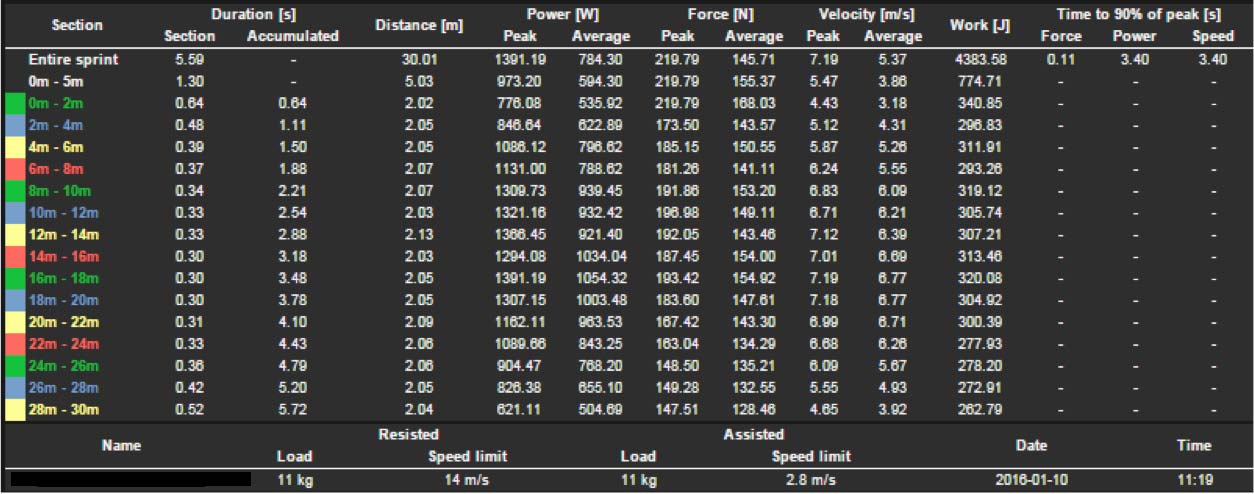
Screenshot 2: The bottom half of this report shows an instant table of force, velocity, power, time, and distance with razor-like precision. The data is displayed on a tablet for instant feedback.
Every athlete has personalized needs with loading, and the key is not killing the elastic response and making it a strength exercise instead of a speed development modality. The 1080 Sprint is not a resistance tool. It’s the offspring of one part speed lab and one part finely tuned resistance equipment.
Winning the Arms Race and Getting the Edge
If you are not doing speed work and playing it too safe you are eventually going to get burned. Not sprinting is putting your head in the sand and betting against the spread. I suggest that every team sport do speed work as fast as they can go with some sort of light resistance, and save the heavy loading for the weight room. Speed training is a precious commodity, so don’t slow it down with heavy loads.
Every professional team should value speed training as a priority. Using light resistance as well as measurement is the future. The 1080 Sprint is not for everyone, as it isn’t a toy and is inappropriate for many programs. If you run a private facility, it’s a great assessment option. For professional teams, it’s the solution for getting athletes safely engaged again in speed. Whatever you do, find a way to sprint in some form. The faster it is, the more likely you’ll get better results.
Suggested Reading
I recommend that readers go to the research and see some of the specific differences and benefits with loading sprints, as each article has unique study designs. Many potentiation studies are produced in a vacuum versus a true season of training that coaches experience. Thanks to George Petrakos for his article on Freelap helping to drive the velocity approach to speed, rather than the body weight loading method of the past.
- Lockie RG, Murphy AJ, and Spinks CD. “Effects of resisted sled towing on sprint kinematics in field-sport athletes.” J Strength Cond Res. 2003;17(4):760-7.
- Alcaraz PE, Palao JM, and Elvira, JLL. “Determining the optimal load for resisted sprint training with sled towing.” J Strength Cond Res. 2009; 23(2) (epub)
- Kawamori N, Newton R, and Nosaka K. “Effects of weighted sled towing on ground reaction force during the acceleration phase of sprint running.” J Sports Sci. 2014;32(12):1139-45.
- Martínez-Valencia MA, Romero-Arenas S, Elvira JL et al. “Effects of Sled Towing on Peak Force, the Rate of Force Development and Sprint Performance During the Acceleration Phase.” J Hum Kinet. 2015;46(1):139-48.
- Okkonen O and Hakkinen K. “Biomechanical comparison between sprint start, sled pulling, and selected squat-type exercises.” J Strength Cond Res. 2013;27(10):2662-73.
- Seitz LB, Reyes A, Tran TT et al. “Increases in lower-body strength transfer positively to sprint performance: A systematic review with meta-analysis.” Sports Med. 2014;44(12):1693-702.
- Cronin J, Hansen K, Kawamori N et al. “Effects of weighted vests and sled towing on sprint kinematics.” Sport Biomech. 2008;7(2):160-72.
- West DJ, Cunningham DJ, Bracken RM et al. “Effects of resisted sprint training on acceleration in professional rugby union players.” J Strength Cond Res. 2013;27(4):1014-8.
- Bachero-Mena B and Gonzalez-Badillo JJ. “Effects of resisted sprint training on acceleration with three different loads accounting for 5, 12.5 and 20% of body mass.” J Strength Cond Res. 2014;28(10):2954-60.
- Rumpf MC, Lockie RG, Cronin JB et al. “The effect of different sprint training methods on sprint performance over various distances: a brief review.” J Strength Cond Res. 2015.
- Petrakos G, Morin JB, and Egan B. “Resisted Sled Sprint Training to Improve Sprint Performance: A Systematic Review.” Sports Med. 2015.
Please share so others may benefit.
[mashshare]



Hello Mr. Valle,
As a parent coaching a HS sophomore female athlete not having access to all of the expensive devices, what do you think about the following plan for a RSS training session?
She is 5’4″ and 115 lbs.
1. 3 sets of 10 m sprints with 25 pounds (for acceleration).
2. 3 sets of 20 or 30 m sprints with 5 to 10 pounds.
3. 2 sets of 30 m un-resisted sprints.
If you think appropriate, please just reply to my email. I really want some feedback. Thanks, Kurt
Kurt,
Regardless of the type of resistance, it’s important that you value the process. A simple way to use Velocity Based Training for sprinting and resistance sprints is to set up either Freelap Timing or use the Dartfish app and mark 10m segments with mini cones. The app is 5 dollars so budgeting should not be an issue. Weight and height are not enough for me as this is based on time so please use the app and test her based on those loads and then come back and share the data so we can help more.
CV
CV,
Thanks for the quick response. I don’t have your background and knowledge base, so just to clarify: I am measuring 10m flys unresisted and then resisted with different loads to determine drop-off percentages? I have the basic Freelap system with only 2 gates. Looking at Dr. Petrakos’ article, it looks like I need 3 gates? If so, I’ll get the DF app.
What about my idea to break this into 2 phases – one short heavier load for off-the-line acceleration, and another lighter load for top speed resistance? Without a 1080 system, this might be a low-tech option.
V/R, Kurt
Kurt,
You can use two gates but three is better. I suggest posting video for review- but like the idea of first ten and last ten of a 30m sprint with different loads and unloaded. The aforementioned suggestion is only two gates. That will be enough information to make a great impact in adjusting the resistive to individualize the load.
CV
Good article. Thank you.
Would be interesting to further compare slight uphill run v using the 1080, in terms of mitigation of injury risk for vMax vs potential gains.